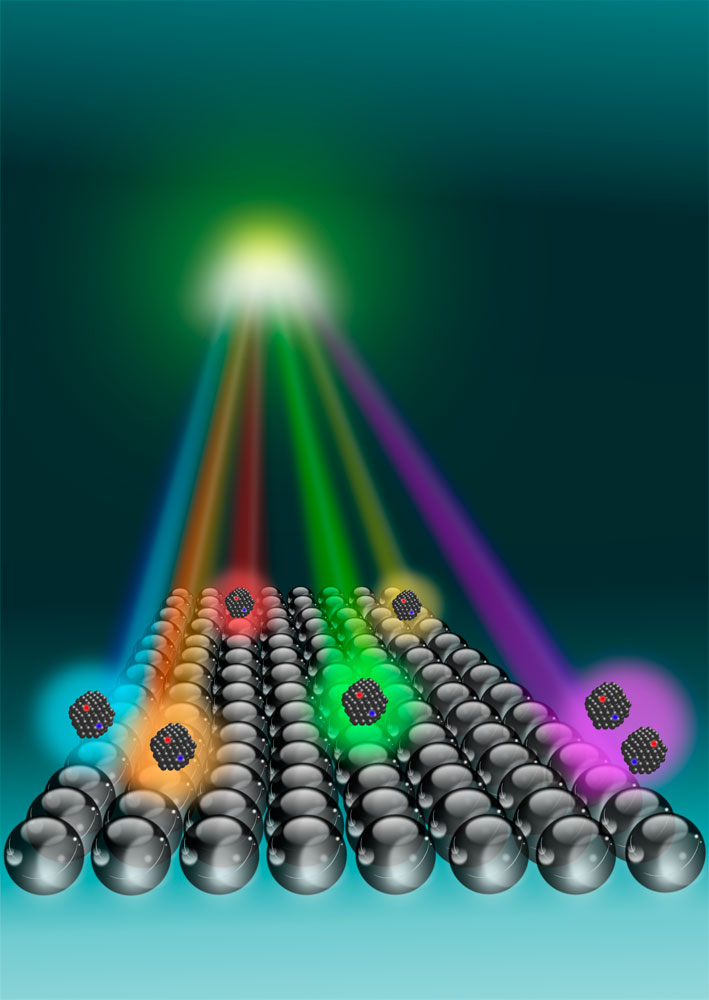Surprising behaviour of electrons in quantum dots may raise the maximum efficiency of solar cells to 44 percent by producing two electrons for one photon.
Researchers in the Chemical Engineering (Applied Sciences) department are quite familiar with quantum nanodots, or q-dots. These tiny lumps of semiconductor material may be tuned to absorb specific wavelengths of light, just be adapting the size (or the material). The silicon q-dots in the most recent study for example measured 3.5 nanometers across and were tuned to infrared radiation (wavelength 800 nm).
But in an STW-funded study, published in ‘Nature Photonics’, the q-dots surprised the researchers by spreading excess energy to neighbouring q-dots, where it may create an extra electron-hole pair. When an incoming photon has more energy than the 1.5 eV it takes to create an electron-hole pair, the extra energy usually gets transferred to crystal vibrations and hence heat. When an incoming photon has twice or more the energy it takes to liberate an electron (the ‘bandgap’), it can theoretically create two electrons for one photon. This seldom happens however because the excess energy usually quickly decays into heat immediately.
Enter the closely packed array of silicon q-dots that Professor Tom Gregorkiewicz’s team from the University of Amsterdam has made by allowing vaporised silicon to condensate on a substrate, like nanoscaled drops of dew. At a distance of 1 nanometer apart, the dots are packed so close that an electron that is hit by a photon “spreads like a tiny cloud and excites an electron in one of the neighbouring dots,” Professor Laurens Siebbeles (Applied Science) explains. The advantage of this quantum mechanical energy transfer is that a high-energy photon creates two electron-hole pairs in two q-dots, thus reducing the chance of energy loss through recombination electrons and positive charges. “Allowing for some energy loss, photons with 2.5 to 3 times the bandgap create two electron-hole pairs,” Prof. Siebbeles explains, adding that this only applies for the high-energy part of the spectrum. Overall, the theoretical efficiency for such charge multiplication solar cells is 44 percent, instead of the current maximum of 33 percent for a conventional solar cell.
There is a snag, however. The created electron-hole pairs need to be separated and drawn from the q-dot to create an external current (which is what solar cells are all about). Prof. Siebbeles is hopeful his group may achieve this one-day by depositing q-dots as thin layers of highly efficient ‘solar’ paint.
Nature Photonics, 18 March 2012, DOI 10.1038/NPHOTON.2012.36
Je vader wist precies hoe lang de eitjes op zondagochtend in het kokende water moesten ronddobberen. Zijn methode was weliswaar niet wetenschappelijk onderbouwd, maar het ging om het resultaat. Voor hem een kwestie van fingerspitzengefühl. En dan ga je op kamers en kom je er achter dat het koken van het perfecte eitje niet in je genen zit.
Met My perfect egg timer hoeft dit geen probleem te zijn. Deze app rekent voor je uit hoe lang het ei aan de kook moet. Tenminste, als je ei een diameter heeft tussen de twee en zes centimeter. Om de kooktijd te kunnen berekenen, moet je namelijk de maat van het ei invoeren. Verder heeft de app de begintemperatuur en je hoogte nodig. Als je toestel gps heeft, bepaalt de timer de hoogte automatisch.
En dan komt het belangrijkste deel: hoe wil de chef-kok zijn ei hebben? De mogelijkheden variëren van vloeibaar tot hard. Druk op start en er komt netjes een instructie op je scherm om water te koken. Heb je eenmaal pruttelend water druk je nogmaals op start en begint het aftellen. Tien seconden voor je ei klaar is, krijg je een waarschuwing zodat je hem op tijd uit het water kunt halen.
Er is ook een Pro-versie beschikbaar die zelf kan bepalen hoe groot het ei is. Makkelijker dan dat wordt het niet.
Naast eieren zijn er genoeg andere dingen die belang hebben bij een goede timing. Niet is gênanter dan een zwartgeblakerde pizza serveren bijvoorbeeld. De Stopwatch app heeft, zoals de naam al doet vermoeden, een stopwatch functie. Daarnaast is er ook een handige tijdklok die aftelt. Op een tiende seconde nauwkeurig bepaal je zo wanneer je pizza klaar is.
Ontzettend handig is de optie om de kleuren van de app te veranderen. Zo voorkom je pijn in je ogen bij nachtelijk gebruik. Voor de alarmen heb je een scala aan verschillende opties. Betaal een kleine 4 euro en je kunt onder andere verschillende timers tegelijk laten lopen.



Comments are closed.